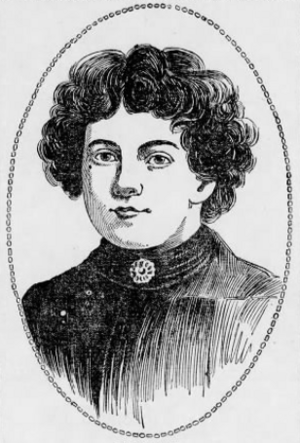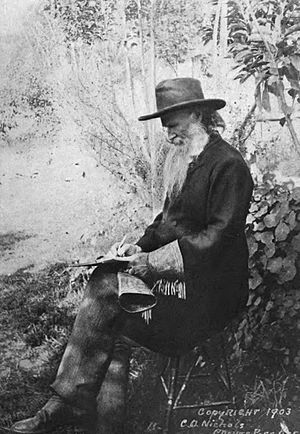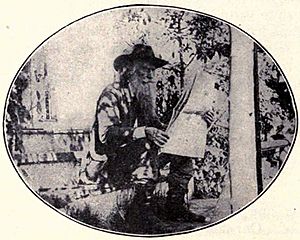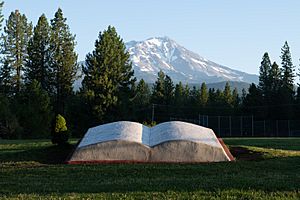Joaquin Miller facts for kids
Quick facts for kids
Joaquin Miller
|
|
|---|---|
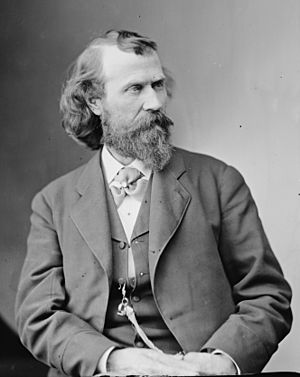
Miller circa 1870-1880
|
|
| Born | Cincinnatus Hiner Miller September 8, 1837 Union County, Indiana, U.S. |
| Died | February 17, 1913 (aged 75) Oakland, California, U.S. |
| Resting place | Joaquin Miller Park |
| Occupation | Poet, author, frontiersman |
| Spouse | Minnie Myrtle Miller (m. 1861; div. 1870), Abigail Leland (m. 1879; death 1913) |
| Children | 4 or 5 |
Cincinnatus Heine Miller (born September 8, 1837 – died February 17, 1913) was an American poet and author. He was much better known by his pen name Joaquin Miller. People often called him the "Poet of the Sierras" because he wrote a lot about the Sierra Nevada mountains, especially in his famous book Songs of the Sierras (1871).
Contents
Joaquin Miller's Early Life and Family
Joaquin Miller's parents were Hulings Miller and Margaret Witt. They got married on January 3, 1836, in Union County, Indiana. Their second son, Cincinnatus Hiner Miller, was born in 1837 near Union County, Indiana.
For some reason, Miller later said he was born on November 10, 1841. He even claimed he was born in a town called Millersville, Indiana, which he said his father founded. This was supposedly while his family was traveling west in a wagon. After leaving Union County, his family moved to Grant County, Indiana, near the Mississinewa River and a Native American reservation.
Miller later changed his middle name from Hiner to Heine. He did this to sound like the famous German poet Heinrich Heine.
Moving to Oregon and California
When Miller was a young boy, around 1850 to 1852, his family moved to Oregon. They settled in the Willamette Valley and started a farm in what is now Lane County.
As a young man, Miller moved to northern California during the exciting time of the California Gold Rush. He had many adventures there. He spent a year living in a Native American village. He was also wounded in a battle with Native Americans. Some of his popular books, like Life Amongst the Modocs and The Battle of Castle Crags, are based on these experiences. In the Castle Crags battle, he was hurt in the cheek and neck by an arrow. He recovered in a mining town called Portuguese Flat.
Wanderings and First Writings
Miller joined William Walker on an expedition to Nicaragua in 1855. In 1857, Miller took part in a trip against the Pit River Tribe. Years later, he said he had actually sided with the Native Americans.
People widely believed that Miller married a Native American woman, possibly a Wintu princess. She supposedly helped him heal after he was wounded. They were rumored to have a daughter named Cali-Shasta. Even though Miller left the area, he later found Cali-Shasta when she was a teenager. He took her to San Francisco so his friend Ina Coolbrith could educate her.
After spending some time in mining camps in northern Idaho, Miller arrived in Canyon City, Oregon, by 1864. There, he was elected as a judge for Grant County. His old cabin in Canyon City is still standing today.
Miller worked many different jobs. He was a mining-camp cook, a lawyer, a judge, and a newspaper writer. He also worked as a Pony Express rider.
Miller earned about $3,000 as a Pony Express rider. He used this money to move to Oregon. With help from his friend, Senator Joseph Lane, he became the editor of a newspaper called the Democratic Register in Eugene. He held this job from March to September 1862. The newspaper was known for supporting the Southern states during the American Civil War. It was eventually forced to close down.
In 1862, Miller married Theresa Dyer. They met in Port Orford, Oregon, and got married just four days later. She also wrote poetry under the name "Minnie Myrtle," and later became known as Minnie Myrtle Miller. They had three children: Maud, George, and Henry.
In 1868, Miller paid to publish 500 copies of his first poetry book, Specimens. It didn't get much attention, and he gave away more copies than he sold. His disappointment showed in his second book, Joaquin et al., which came out the next year.
Theresa Dyer filed for divorce in 1870. The court granted the divorce, and she got custody of Henry. The two older children stayed with her mother. Miller was ordered to pay child support.
Joaquin Miller's Travels and Fame
Miller sent a copy of Joaquin, et al. to another writer, Bret Harte. Harte told him to avoid "faults of excess" but also encouraged him, saying, "you are on your way to become a poet." In July 1870, Miller traveled to San Francisco. There, he became friends with Charles Warren Stoddard and Ina Coolbrith.
Miller then went to England, where he became quite famous. People there saw him as an interesting person from the American frontier. In May 1871, Miller published Songs of the Sierras in England. This book made his nickname, "Poet of the Sierras," stick. The British newspapers and a group of artists called the Pre-Raphaelite Brotherhood liked his work a lot.
While in England, Miller was one of the few Americans invited to join the Savage Club. He left England suddenly in September 1871 and arrived in New York. He visited his dying brother in Easton, Pennsylvania, before returning to Oregon. His father passed away shortly after. Miller eventually settled in California. He grew fruit and continued to publish his poems and other writings.
In 1877, Miller turned his book First Fam'lies of the Sierras into a play called The Danites, or, the Heart of the Sierras. It opened in New York and became very popular. The play was about a group of people called Danites hunting the daughter of a man who killed Joseph Smith. It was one of the most successful plays of its kind at the time. The Danites was performed for many weeks and became as popular as Uncle Tom's Cabin. Miller later said he regretted the play's negative tone towards a certain religious group.
Miller married for a third time on September 8, 1879, to Abigail Leland in New York City.
Later Years and Passing
In 1886, Miller published The Destruction of Gotham. That same year, he moved to Oakland, California. He built a home for himself that he called "The Abbey" on land he named "The Hights". He lived there until he passed away in 1913.
A Japanese poet named Yone Noguchi came to The Hights in 1894. He stayed there for four years, working without pay in exchange for a place to live and food. While living there, he published his first book. Noguchi called Miller "the most natural man." However, he also said those years were his hardest in the United States.
In 1897, Miller traveled to the Yukon as a newspaper reporter. He saw Alaska for the first time on July 30. His reports often made the trip sound easy and cheap, even though he wrote many of them before he even got to Alaska. Miller himself almost froze to death and lost two toes to frostbite.
Joaquin Miller passed away on February 17, 1913. He was surrounded by his friends and family. His last words were "Take me away; take me away!" He had asked his friends to cremate him on a special funeral pyre he built at The Hights. He wanted no religious ceremony and no embalming. However, his wishes were mostly not followed. His funeral on February 19 attracted thousands of curious people. The speaker at the funeral called Miller "the last of America's great poets." On May 23, members of the Bohemian Club and the Press Club returned to Miller's funeral pyre. They burned the urn with his ashes, allowing them to scatter. Miller did not leave a will. His property, worth about $100,000, was divided between his wife, Abigail, and his daughter, Juanita.
Joaquin Miller's Legacy
A historical marker for Joaquin Miller's birthplace was put up on October 10, 1915, in Union County, Indiana. The Joaquin Miller Cabin is located in Washington, D.C.
The Hights, the home Miller built in Oakland, was bought by the city in 1919. It is now known as the Joaquin Miller House and is part of Joaquin Miller Park. It is a special California Historical Landmark. Miller himself planted many trees around his home. He also built his own funeral pyre and monuments dedicated to important figures like Moses, General John C. Frémont, and poets Robert Browning and Elizabeth Barrett Browning.
Several schools in California are named after him, including Miller Middle School in San Jose, Joaquin Miller Elementary School in Oakland, and Joaquin Miller Elementary School in Burbank.
In 1965, actor Sean McClory played Miller in an episode of the TV show Death Valley Days. In 2012, artist Mark Oliver created a large statue called "Joaquin's Book" in Hoo Hoo Park in McCloud, California. This location is near where Miller lived with the Wintu people.
List of Joaquin Miller's Works
- Specimens (1868)
- Joaquin et al. (1869)
- Pacific Poems (1871)
- Songs of the Sierras (1871)
- Songs of the Sun-Lands (1873)
- Life Amongst the Modocs (1873)
- Arizonian (1874)
- First Fam'lies of the Sierras (1875–76)
- The One Fair Woman (1876)
- The Baroness of New York (1877)
- The Danites (1878)
- Songs of Italy (1878)
- Memorie and rime (1884)
- The Destruction of Gotham (1886)
- Songs of the Soul (1896)
- True Bear Stories (1900)
- Chants for the Boer (1900)
- The Complete Poetical Works of Joaquin Miller (1902)
- As It Was in the Beginning (1903)
- The Building of the City Beautiful (1905)
- Light: A Narrative Poem (1907)
- Joaquin Miller's Poems, with an introduction and autobiography (6 vols., San Francisco, 1909–1910)
- The Danites in the Sierras (1910)
- 49: The Gold-Seekers of the Sierras (1910)
- An Elk Hunt
- The Battle of Castle Crags
See also
 In Spanish: Joaquin Miller para niños
In Spanish: Joaquin Miller para niños


